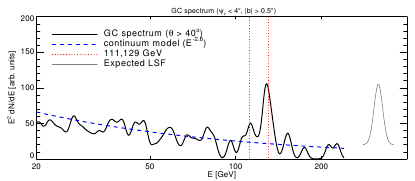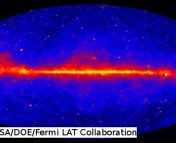Title: Strong Evidence for Gamma-ray Line Emission from the Inner Galaxy
Authors: Meng Su, Doug Finkbeiner
First Author’s Institution: Harvard University
In the eight decades since the discovery of dark matter, physicists and astronomers have been struggling to piece together a consistent picture for the particles that are producing this bizarre gravitational signature on galaxies and the large scale structure of the universe. Scientists on Earth have thrown every tool they have at the problem, including experiments trying to directly detect certain model dark matter particles whizzing around the Earth and to actually create dark matter particles using the Large Hadron Collider. A few authors even asked how effective the human body is as a dark matter detector.
But of course, we discovered dark matter using astronomical observations, and there is almost certainly more to learn about dark matter from beyond the Earth. In particular, when dark matter particles collide and annihilate, they should produce a continuum of high-energy, gamma-ray photons plus excess emission at one or more specific energies (lines) related to the particle mass. If we see a high-energy gamma-ray emission line from a place in the universe where we think there is a high concentration of dark matter (e.g. tiny dwarf galaxies, galaxy clusters, or the center of our own galaxy), there would be tremendous implications for theory.
On March 6th, Bringmann et al. posted to the arXiv an analysis of data from the Fermi gamma-ray space telescope looking for such an annihilation signature. They report finding an emission line that could correspond to a dark matter particle with mass of ~150 GeV with a confidence of ~3-4σ. This is tantalizing, but not conclusive. Since then, in less than four months time, about two dozen additional studies have examined this claim, taking a closer look at the data collected by Fermi in its 3.7 yrs of observations to date.
In today’s Wide Field Survey Lunch at the Harvard-Smithsonian Center for Astrophysics, Doug Finkbeiner gave an interesting talk describing new work on this subject done in collaboration with graduate student Meng Su (Su & Finkbeiner 2012, posted on the arXiv on June 7). They bring a few new tools to bear on the problem and report “strong evidence” for a detection of line emission from the Galactic center (~5-6σ confidence; see figure below).

The Fermi gamma-ray spectrum from near the Galactic center, showing the emission line near ~130 GeV. From Su & Finkbeiner Figure 18.
First, they make maps showing all the photons Fermi has detected in its 3.7 yr of surveying the entire sky, once every 3 hrs (see figure below). They use these maps to model the spatial distribution of background gamma-ray emission unrelated to the purported line. Subtracting the model, they make another map showing where the excess line emission is actually coming from. They find that the 130 GeV photons above the background are coming from near the Galactic center, although significantly offset by ~2 degrees. The authors go through a variety of analyses to demonstrate that the emission has an astrophysical origin rather than being a bogus instrumental effect.
They fit this excess line emission with a variety of models. The model that fits best represents the dark matter annihilation source as the square of the density distribution of dark matter in the Milky Way (using an Einasto profile) projected along our line of sight, but off-center by that curious 2 degrees. It’s possible that the annihilation source could be pulled off-center by dynamics relating to the Milky Way’s bar, but it’s also possible that that the line emission could be produced by an astrophysical source other than dark matter annihilation at the Galactic center.
Regardless of its source, it’s important to remember that all of this discussion of line emission is based on Fermi’s detection of ~50 photons near 130 GeV from near the Galactic Center. Finkbeiner was clear in his talk that he does not consider this a “discovery,” but he advocates for more resources to study the issue. Su & Finkbeiner suggest altering the survey strategy of the Fermi telescope; they say that if it spent 40% of its time looking at the Galactic center in a way optimized for high energy-resolution, the question of line emission could be answered definitively with just one more year of observations.

A map of the local background for gamma-ray emission at a particular energy (left), and another map showing where the excess 130 GeV line emisison is coming from (right). The excess (black dot) is confined to within a few degrees of the Galactic center, suggesting a possible dark matter origin. From Figure 3 of Su & Finkbeiner 2012.





130GeV is equivalent to a frequency of almost 2×10^{26}Hz which indicates neutrinos.
I’m sorry, but that’s incorrect. Neutrinos have masses, but significantly less than an eV.
The 130 GeV signal corresponds to a ~65 GeV dark matter particle, assumedly some kind of WIMP – the exact nature of which depends on your favorite model for physics beyond the standard model of particle physics. Some common theoretical suspects include the neutralino, the gravatino, and other cantidates for the lightest supersymmetric particle.
That’s not quite right either. It would be a ~130 GeV Dark matter particle, not a 65 GeV dark matter particle – because the annihilation will have to go to two photons in the final state.
You can’t put all the energy into just a single photon, because it violates momentum conservation. Think of moving to the center of mass frame of the two-dark matter particle system, then the initial momentum is 0. However, the gamma-ray moves at the speed of light in every rest frame, so it has momentum E/c. Thus you need two gamma-rays moving in opposite directions in order to make the final momentum 0 in the CM frame of the DM particles.